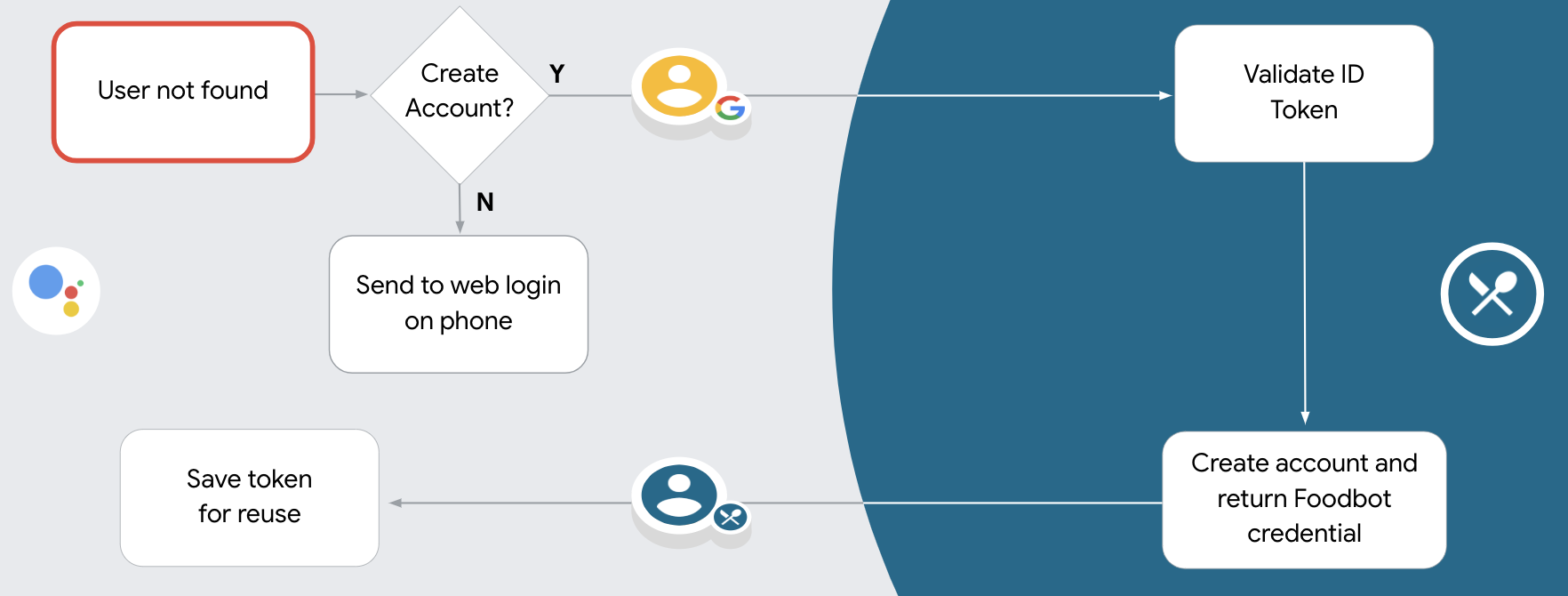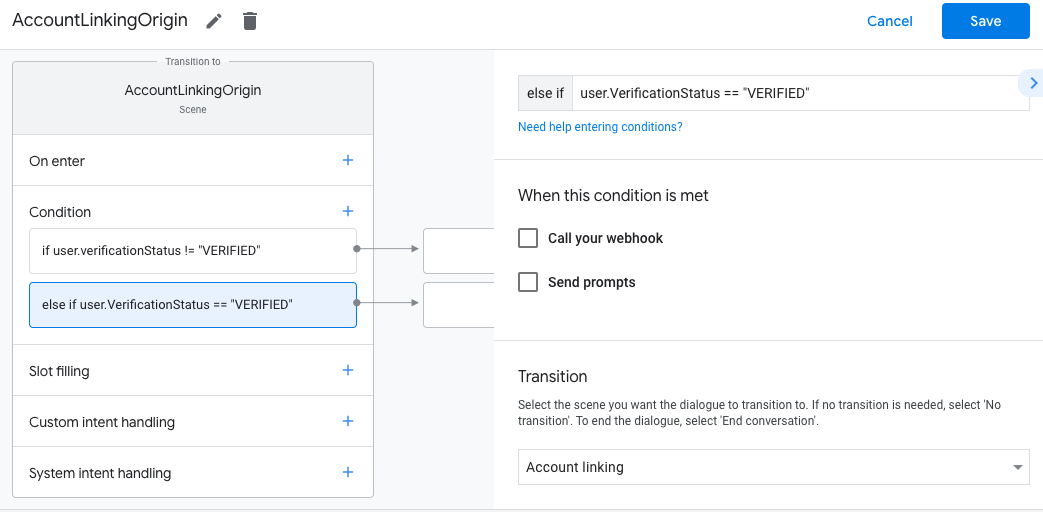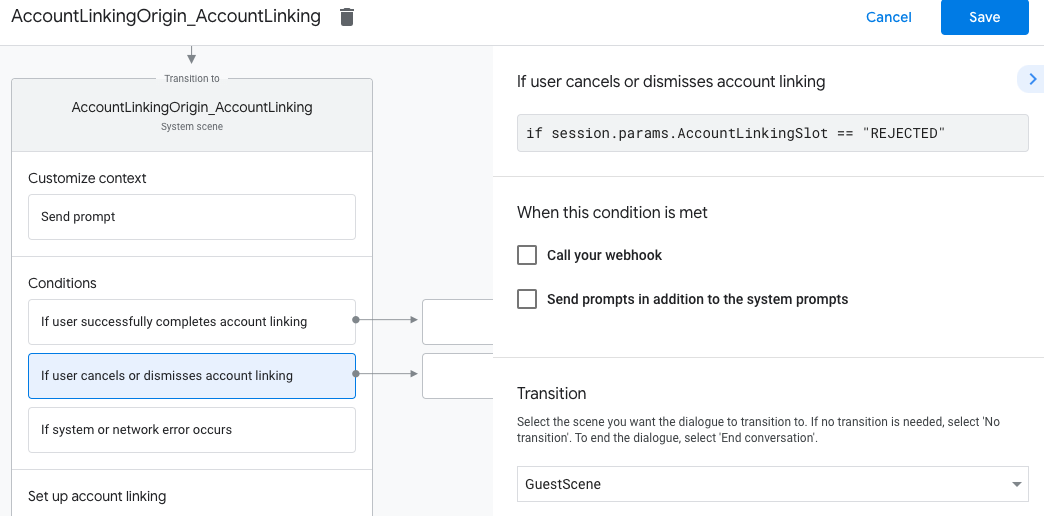基于 OAuth 的 Google 登录“精简”关联类型在基于 OAuth 的账号关联之上添加了 Google 登录。这不仅可为 Google 用户提供顺畅的语音关联体验,还可让使用非 Google 身份注册您服务的用户关联账号。
这种关联类型从 Google 登录开始,可让您检查用户的 Google 个人资料信息是否已存在于您的系统中。如果您的系统中未找到用户的信息,系统会开始执行标准 OAuth 流程。用户还可以选择使用其 Google 个人资料信息创建新账号。

如需使用简化的关联类型执行账号关联,请按以下常规步骤操作:
- 首先,请征求用户同意以访问其 Google 个人资料。
- 使用其个人资料中的信息来识别用户。
- 如果您在身份验证系统中找不到匹配的 Google 用户,系统会根据您在 Actions 控制台中配置的操作项目来确定后续流程,即允许通过语音创建用户账号,还是仅允许在您的网站上创建用户账号。
- 如果您允许通过语音创建账号,请验证从 Google 收到的 ID 令牌。然后,您可以根据 ID 令牌中包含的个人资料信息创建用户。
- 如果您不允许通过语音创建账号,系统会将用户转移到浏览器,用户可以在其中加载您的授权页面并完成用户创建流程。

支持通过语音创建账号
如果您允许通过语音创建用户账号,助理会询问用户是否要执行以下操作:
- 使用其 Google 账号信息在您的系统上创建新账号,或
- 如果用户有现有的非 Google 账号,请使用其他账号登录您的身份验证系统。
如果您想尽可能减少账号创建流程中的阻力,建议允许通过语音创建账号。如果用户想使用现有的非 Google 账号登录,才需要退出语音流程。
禁止通过语音创建账号
如果您禁止通过语音创建用户账号,Google 助理会打开您为用户身份验证提供的网站网址。如果互动发生在没有屏幕的设备上,Google 助理会引导用户前往手机,以继续完成账号关联流程。
建议在以下情况下禁止创建:
您不希望允许没有 Google 账号的用户创建新用户账号,而是希望他们与您身份验证系统中的现有用户账号相关联。例如,如果您提供会员回馈计划,则可能需要确保用户不会丢失其现有账号中累积的积分。
您需要完全控制账号创建流程。例如,如果您需要在账号创建期间向用户显示服务条款,则可以禁止创建账号。
实现基于 OAuth 的 Google 登录“简化”关联
账号通过行业标准 OAuth 2.0 流程进行关联。 Actions on Google 支持隐式流程和授权代码流程。
在隐式代码流程中,Google 会在用户浏览器中打开您的授权端点。成功登录后,系统会向 Google 返回长期访问令牌。现在,从 Google 助理向你的 Action 发送的每个请求中都包含此访问令牌。
在授权代码流程中,您需要两个端点:
- 授权端点,该端点负责向尚未登录的用户显示登录界面,并以短期授权代码的形式记录所请求的访问。
- 令牌交换端点,负责两种类型的交换:
- 将授权代码交换为长期刷新令牌和短期访问令牌。用户完成帐号关联流程后,系统会进行这种交换。
- 将长期刷新令牌换成短期访问令牌。Google 需要新访问令牌时,由于此令牌已过期,因此会进行此交换。
虽然隐式代码流程的实现更简单,但 Google 建议通过隐式流程发出的访问令牌永远不会过期,因为将令牌过期与隐式流程一起使用会强制用户再次关联其帐号。如果出于安全考虑需要令牌到期,强烈建议您考虑使用身份验证代码流程。
配置项目
如需将项目配置为使用精简版关联,请按以下步骤操作:
- 打开 Actions 控制台,然后选择要使用的项目。
- 点击开发标签页,然后选择账号关联。
- 启用账号关联旁边的开关。
- 在账号创建部分中,选择是。
在关联类型中,选择 OAuth 和 Google 登录以及隐式。

在客户信息中,执行以下操作:
- 为 Actions 发给 Google 的客户端 ID 赋值,以标识来自 Google 的请求。
- 插入授权端点和令牌交换端点的网址。
点击保存。
实现 OAuth 服务器
为了支持 OAuth 2.0 隐式流程,您的服务会进行授权 端点。此端点负责 就数据访问征得用户同意。授权端点 向尚未登录的用户显示登录界面,并记录 同意所请求的访问。
当您的 Action 需要调用您的某项授权的 API 时,Google 会使用 此端点来获得用户许可,以在其上调用这些 API 。
由 Google 发起的典型 OAuth 2.0 隐式流会话具有以下特征: 以下流程:
- Google 会在用户的浏览器中打开您的授权端点。通过 如果用户尚未登录,则可以登录,并且授予 Google 访问 通过您的 API 访问其数据(如果尚未授予权限)。
- 您的服务会创建一个访问令牌并将其返回给 通过使用访问令牌将用户的浏览器重定向回 Google, 附件。
- Google 调用您的服务的 API,并使用 。您的服务会验证访问令牌是否向 Google 授予 访问 API 的授权,然后完成 API 调用。
处理授权请求
当您的 Action 需要通过 OAuth 2.0 隐式流程执行账号关联时, Google 会通过包含以下内容的请求将用户发送到您的授权端点: 以下参数:
| 授权端点参数 | |
|---|---|
client_id |
您分配给 Google 的客户 ID。 |
redirect_uri |
此请求的响应发送到的网址。 |
state |
将一个在 重定向 URI。 |
response_type |
要在响应中返回的值的类型。对于 OAuth 2.0 隐式
则响应类型始终为 token。 |
例如,如果您的授权端点可通过 https://myservice.example.com/auth 访问,
请求可能如下所示:
GET https://myservice.example.com/auth?client_id=GOOGLE_CLIENT_ID&redirect_uri=REDIRECT_URI&state=STATE_STRING&response_type=token
为了让授权端点能够处理登录请求,请执行以下步骤:
验证
client_id和redirect_uri值, 防止向意外或配置错误的客户端应用授予访问权限:- 确认
client_id是否与您的客户端 ID 匹配 分配给 Google。 - 确认
redirect_uri指定的网址 参数的格式如下:https://oauth-redirect.googleusercontent.com/r/YOUR_PROJECT_ID
- 确认
检查用户是否已登录您的服务。如果用户未登录 中,完成服务的登录或注册流程。
生成 Google 将用于访问您的 API 的访问令牌。通过 访问令牌可以是任何字符串值,但必须唯一地表示 令牌对应的用户和客户端,且不得被猜到。
发送 HTTP 响应,将用户浏览器重定向到相应网址 由
redirect_uri参数指定。添加所有 以下参数:access_token:您刚刚生成的访问令牌token_type:字符串bearerstate:原始状态的未修改状态值 请求 以下是生成的网址示例:https://oauth-redirect.googleusercontent.com/r/YOUR_PROJECT_ID#access_token=ACCESS_TOKEN&token_type=bearer&state=STATE_STRING
Google 的 OAuth 2.0 重定向处理程序将收到访问令牌并确认
state 值没有更改。在 Google 获得
访问令牌,则 Google 会将该令牌附加到后续调用
作为 AppRequest 的一部分添加到您的 Action。
Handle automatic linking
After the user gives your Action consent to access their Google profile, Google sends a request that contains a signed assertion of the Google user's identity. The assertion contains information that includes the user's Google Account ID, name, and email address. The token exchange endpoint configured for your project handles that request.
If the corresponding Google account is already present in your authentication system,
your token exchange endpoint returns a token for the user. If the Google account doesn't
match an existing user, your token exchange endpoint returns a user_not_found error.
The request has the following form:
POST /token HTTP/1.1 Host: oauth2.example.com Content-Type: application/x-www-form-urlencoded grant_type=urn:ietf:params:oauth:grant-type:jwt-bearer&intent=get&assertion=JWT&consent_code=CONSENT_CODE&scope=SCOPES
Your token exchange endpoint must be able to handle the following parameters:
| Token endpoint parameters | |
|---|---|
grant_type |
The type of token being exchanged. For these requests, this
parameter has the value urn:ietf:params:oauth:grant-type:jwt-bearer. |
intent |
For these requests, the value of this parameter is `get`. |
assertion |
A JSON Web Token (JWT) that provides a signed assertion of the Google user's identity. The JWT contains information that includes the user's Google Account ID, name, and email address. |
consent_code |
Optional: When present, a one-time code that indicates that the user has granted consent for your Action to access the specified scopes. |
scope |
Optional: Any scopes you configured Google to request from users. |
When your token exchange endpoint receives the linking request, it should do the following:
Validate and decode the JWT assertion
You can validate and decode the JWT assertion by using a JWT-decoding library for your language. Use Google's public keys (available in JWK or PEM format) to verify the token's signature.
When decoded, the JWT assertion looks like the following example:
{ "sub": 1234567890, // The unique ID of the user's Google Account "iss": "https://accounts.google.com", // The assertion's issuer "aud": "123-abc.apps.googleusercontent.com", // Your server's client ID "iat": 233366400, // Unix timestamp of the assertion's creation time "exp": 233370000, // Unix timestamp of the assertion's expiration time "name": "Jan Jansen", "given_name": "Jan", "family_name": "Jansen", "email": "jan@gmail.com", // If present, the user's email address "locale": "en_US" }
In addition to verifying the token's signature, verify that the assertion's issuer
(iss field) is https://accounts.google.com and that the audience (aud field)
is the client ID assigned to your Action.
Check if the Google account is already present in your authentication system
Check whether either of the following conditions are true:
- The Google Account ID, found in the assertion's
subfield, is in your user database. - The email address in the assertion matches a user in your user database.
If either condition is true, the user has already signed up and you can issue an access token.
If neither the Google Account ID nor the email address specified in the assertion
matches a user in your database, the user hasn't signed up yet. In this case, your
token exchange endpoint should reply with a HTTP 401 error, that specifies error=user_not_found,
as in the following example:
HTTP/1.1 401 Unauthorized
Content-Type: application/json;charset=UTF-8
{
"error":"user_not_found",
}
user_not_found error, Google
calls your token exchange endpoint with the value of the intent parameter
set to create and sending an ID token that contains the user's profile information
with the request.
Handle account creation via Google Sign-In
When a user needs to create an account on your service, Google makes a
request to your token exchange endpoint that specifies
intent=create, as in the following example:
POST /token HTTP/1.1 Host: oauth2.example.com Content-Type: application/x-www-form-urlencoded response_type=token&grant_type=urn:ietf:params:oauth:grant-type:jwt-bearer&scope=SCOPES&intent=create&consent_code=CONSENT_CODE&assertion=JWT[&NEW_ACCOUNT_INFO]
The assertion parameter contains A JSON Web Token (JWT) that provides
a signed assertion of the Google user's identity. The JWT contains information
that includes the user's Google Account ID, name, and email address, which you can use
to create a new account on your service.
To respond to account creation requests, your token exchange endpoint must do the following:
Validate and decode the JWT assertion
You can validate and decode the JWT assertion by using a JWT-decoding library for your language. Use Google's public keys (available in JWK or PEM format) to verify the token's signature.
When decoded, the JWT assertion looks like the following example:
{ "sub": 1234567890, // The unique ID of the user's Google Account "iss": "https://accounts.google.com", // The assertion's issuer "aud": "123-abc.apps.googleusercontent.com", // Your server's client ID "iat": 233366400, // Unix timestamp of the assertion's creation time "exp": 233370000, // Unix timestamp of the assertion's expiration time "name": "Jan Jansen", "given_name": "Jan", "family_name": "Jansen", "email": "jan@gmail.com", // If present, the user's email address "locale": "en_US" }
In addition to verifying the token's signature, verify that the assertion's issuer
(iss field) is https://accounts.google.com and that the audience (aud field)
is the client ID assigned to your Action.
Validate user information and create new account
Check whether either of the following conditions are true:
- The Google Account ID, found in the assertion's
subfield, is in your user database. - The email address in the assertion matches a user in your user database.
If either condition is true, prompt the user to link their existing account with
their Google Account by responding to the request with an HTTP 401 error, specifying
error=linking_error and the user's email address as the login_hint, as in the
following example:
HTTP/1.1 401 Unauthorized
Content-Type: application/json;charset=UTF-8
{
"error":"linking_error",
"login_hint":"foo@bar.com"
}
If neither condition is true, create a new user account using the information provided in the JWT. New accounts do not typically have a password set. It is recommended that you add Google Sign In to other platforms to enable users to log in via Google across the surfaces of your application. Alternatively, you can email the user a link that starts your password recovery flow to allow the user to set a password for signing in on other platforms.
When the creation is completed, issue an access token and return the values in a JSON object in the body of your HTTPS response, like in the following example:
{ "token_type": "Bearer", "access_token": "ACCESS_TOKEN", "expires_in": SECONDS_TO_EXPIRATION }
为身份验证流程设计语音界面
检查用户是否已通过验证,并启动账号关联流程
- 在 Actions 控制台中打开您的 Actions Builder 项目。
- 创建新场景以在您的 Action 中启动账号关联:
- 点击场景。
- 点击添加 (+) 图标以添加新场景。
- 在新创建的场景中,点击条件的添加 add 图标。
- 添加一个条件,用于检查与对话关联的用户是否为已验证的用户。如果检查失败,您的 Action 将无法在对话期间执行账号关联,并且应回退到提供无需账号关联的功能。
- 在条件下的
Enter new expression字段中,输入以下逻辑:user.verificationStatus != "VERIFIED" - 在过渡下,选择不需要关联账号的场景,或选择仅限访客使用的功能的入口点场景。
- 在条件下的

- 点击条件对应的添加 add 图标。
- 添加一个条件,以便在用户没有关联身份时触发账号关联流程。
- 在条件下的
Enter new expression字段中,输入以下逻辑:user.verificationStatus == "VERIFIED" - 在过渡下,选择账号关联系统场景。
- 点击保存。
- 在条件下的

保存后,系统会在您的项目中添加一个名为 <SceneName>_AccountLinking 的新账号关联系统场景。
自定义账号关联场景
- 在场景下,选择账号关联系统场景。
- 点击发送提示,然后添加简短的句子,向用户说明该操作需要访问其身份信息的原因(例如“保存您的偏好设置”)。
- 点击保存。

- 在条件下,点击如果用户成功完成账号关联。
- 配置用户同意关联账号后,流程应如何继续。 例如,调用网络钩子来处理所需的任何自定义业务逻辑,然后转换回原始场景。
- 点击保存。

- 在条件下,点击如果用户取消或关闭账号关联。
- 配置用户不同意关联账号时流程应如何继续。例如,发送确认消息并重定向到提供不需要关联账号的功能的场景。
- 点击保存。

- 在条件下,点击如果发生系统或网络错误。
- 配置在因系统或网络错误而无法完成账号关联流程时,流程应如何继续。 例如,发送确认消息并重定向到提供不需要关联账号的功能的场景。
- 点击保存。
处理数据访问请求
如果助理请求包含访问令牌,请先检查该访问令牌是否有效且未过期,然后从用户账号数据库中检索与该令牌关联的用户账号。

